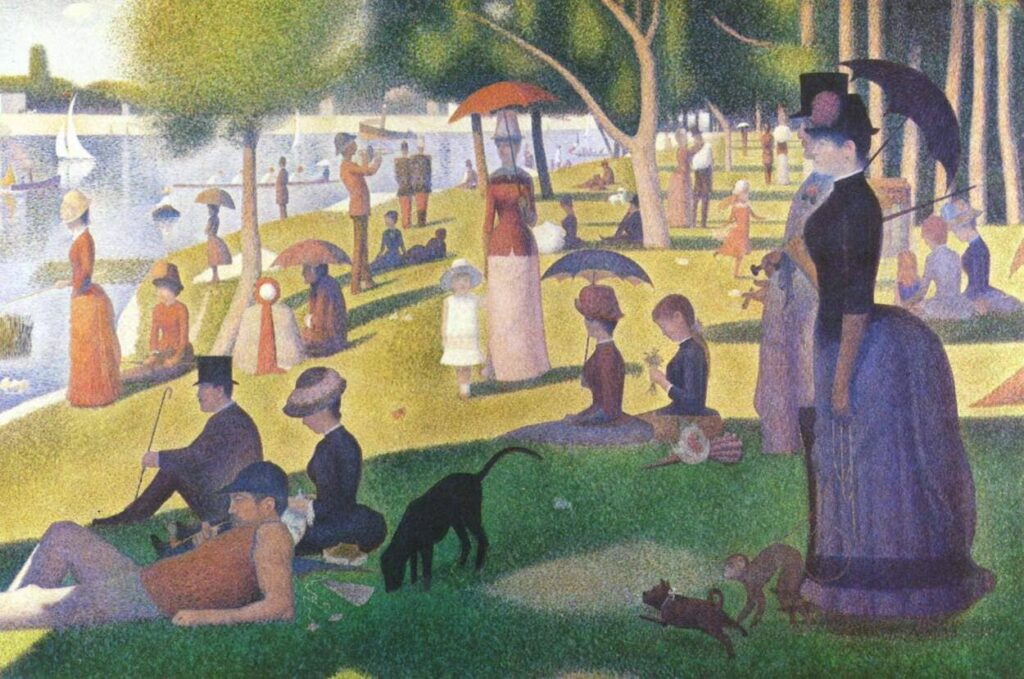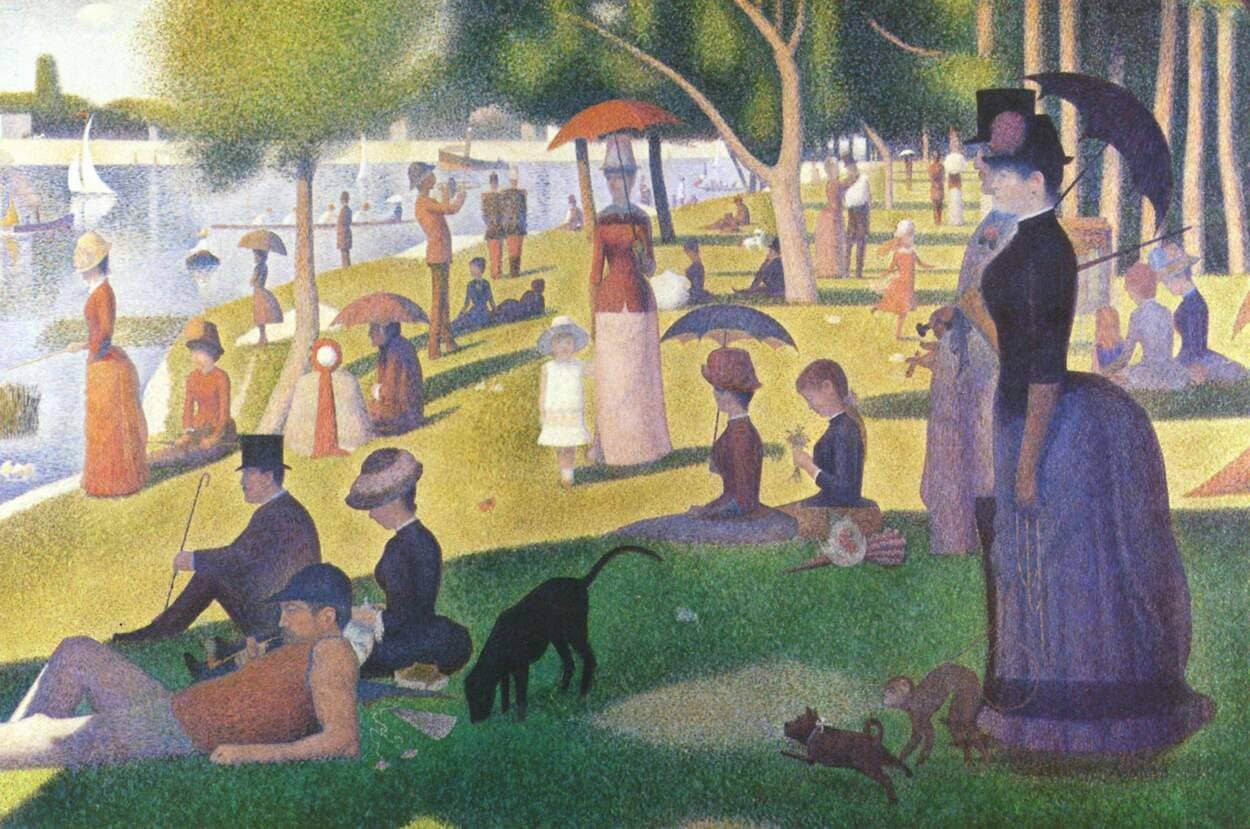Georges Seurat, creator of Pointillism

Broadly speaking, we can define Pointillism as a pictorial technique based on the use of small dots that, together form a clear image, full of details and nuances. It emerged in the 19th century, from the hands of the neo-impressionist painter, Georges Pierre Seurat, after a laborious scientific investigation on the effects that color produces in the eye and in the human mind.
This novel technique was picked up by other greats of the art of the time, like Vincent van Gogh, managing to create spectacular and immortal works, known and admired by everyone. But what are the main characteristics and how did this pictorial technique arise?
Georges Seurat and the Birth of Pointillism
To understand the birth of Pointillism we must travel back to Paris 1884 when the Society of Independent Artists was created, established by a group of French artists whose motto was “without juries or awards,” thus asserting the right to share their creations without needing the approval of experts to conduct their exhibitions.
Within this group of artists was the French painter Georges Pierre Seurat, who had already consolidated a new, especially innovative technique, and whose first public exhibition would be held that year. From then on, and thanks to its enormous acceptance, other painters would take it as a reference for their new creations.
Figures such as Paul Signac, who was a close collaborator of Seurat for the perfection of the technique, or Henri Edmond Cross, Vlaho Bukovac and, even, the very same Van Gogh, were seduced by this new pictorial expression that offered, in addition to beauty, a precise and especially careful technique.
Pointillism Today
By 1890 the technique of Pointillism had reached its highest success, however, from that moment on, it went into decline, almost being forgotten. However, thanks to the tenacity of new artists, Pointillism continues to attract the interest of new creators, also being a highly recommended technique in other competencies such as teaching, alternative therapies, fashion, or body art.
The Technique of Pointillism and Georges Seurat
For a quick and uncomplicated definition, we could say that it involves the use of small dots on the canvas that, at first glance, might seem to have no meaning but that, as a whole, form completely recognizable figures and landscapes.
It is an extremely meticulous work that stems from a scientific study carried out with the association made by the human mind, through the eye, to capture the vibration of colors. This luminous vibration created through the application of different points, seen from a certain distance, creates a completely recognizable image.
Main Features
- It is important that the distance between the dots is precise and necessary so that, when looking at the painting from a distance, it offers us the image we want to capture.
- The colors used in Pointillism are primary, at no time does the painter mix them, except with white to create a lighter shade.
- Depending on the arrangement of the dots, their distance and tones, the painting will offer us a sensation, greater or lesser, of depth and volume. Therefore, it requires a very meticulous study before employing the technique without order or control.
Georges Seurat, the Father of Pointillism
Although some artists tried to make their small forays approaching the technique of Pointillism, it was the Frenchman Georges Seurat who was the true father of this novel form of expression. But how did he get there?
Georges Seurat and his strong vocation from childhood
He was born in Paris in 1859. Seurat was introduced to the world of painting from his tender childhood by his maternal uncle, a textile merchant. Seeing the child’s hobby and that he was refining his technique, he began to attend evening classes at the municipal school of drawing, being a standout student in the class of sculptor Justin Lequien.
A few years later he would enter the School of Fine Arts in Paris. There he would meet other great masters of painting and companions with whom he would start researching new techniques. However, his beginnings, as a professional painter, were not well received by the critics, which led him to create, along with other artists, the Society of Independent Artists, where any type of criticism or submission was rejected.
The beginning of Pointillism
It would be in 1884 when he met who would be his companion in the creation of this new technique, Paul Signac. With him he shared his concerns, initially scientific, in the creation of new works starting from the arrangement of different points on the canvas. Thus, a year later the creation of what would be, and is, undoubtedly his masterpiece began: Sunday Afternoon on the Island of La Grande Jatte. Such was its complexity, that it took him two years to complete it.
Thanks to the success obtained by this new technique, he decides to create the group of neo-impressionists, to which great artists of the time join who seek to endow their works with a new technique that goes beyond what was known until then.
His most famous paintings
Although the most successful was Sunday Afternoon on the Island of La Grande Jatte, Seurat’s work is especially wide and many of them are occupying privileged places in the great museums and art galleries around the world. Some of them:
- Bathing at Asnières
- Les Bords de Emil
- Poseuse de Face
- La Seine à la Grande-Jatte
- The Circus Parade
- The Models
- La Manche à Gravelines
- The Chahut
- L’lle de la Grande Jatte
- The Eiffel Tower
- Outskirts
- The Circus
Seurat's Legacy
His unexpected death, when he was only 32 years old, created great consternation among his friends and artistic circles of the moment. However, and although the technique survived him for a while, it fell into decline, especially because without its leader, Pointillism had been orphaned. Most of the followers and students soon lost interest in this technique, dedicating themselves to completely different ones.
Many years have had to pass for Seurat’s legacy to find its true raison d’être, being conceived as a precise, almost mathematical technique, full of values, not only artistic, but also scientific. Thus, at this moment it can be said that it was, and continues to be, one of the most influential techniques for the new artists who have emerged throughout the 20th and 21st centuries.
Famous works of Pointillism, beyond Georges Seurat
Such was the influence of this novel technique, that there were many artists of the time who wanted to imitate it. Among them we can highlight a young Van Gogh who did not want to overlook this artistic expression.
Among the most famous works that have followed the technique of Pointillism, beyond those of Seurat himself, we find:
- Vincent van Gogh: The Starry Night, Olive Trees with Yellow Sky and Sun, and Self-portrait of 1887.
- Paul Signac: The Pine in Saint Tropez and A Sunday.
- Theo van Rysselberghe: The regatta, The beach at Ambleteuse at Low Tide
- Henri Edmond Cross: View of the church of Santa Maria degli Angeli, near Assisi; The Iles d’or
Today and the future of Pointillism
Artists are always looking for new, novel, and groundbreaking techniques for their new creations. Although some turn out to be especially fleeting, others remain throughout history, being applied in new ways, not merely artistic, but as creative alternatives for the human being. This is the case of Pointillism which, among many other applications, has become a perfect ally for, for example, school creative tasks, helping, not only to foster their imaginative side, but also to develop their fine motor skills.
>> Related Article: What is Pointillism?

